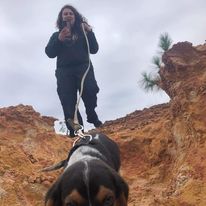ADVANCED TRACKING/ TRAILING “SCENT SPECIFIC”

To be eligible to certify a K-9. You must be a full time paid law enforcement officer (Reserve officer), paid full time fire fighter, or in the military with assigned search and rescue duties, or state licensed private security company, or corrections officer, member of a Search and Rescue K9 Team, either local, state, federal or retired law enforcement or correctional officer in good standing with the state you worked for prior to retirement. Be a volunteer actively involved in Search and Rescue, Fire fighter or EMS team. The handler must be at least eighteen (18) years of age to certify with a K9.
EVALUATION REQUIREMENT
This test is designed to test the proficiency of the canine to follow a trail and locate a specific suspect. This is known as “scent specific” or “scent discrimination.” The track may start on either hard or soft surface. The canine must work the track to at least 70% accuracy recorded via GPS and the handler must show proficiency in reading the body language of the canine on the track. Wind direction and speed must be taken into account for the 70% score by the evaluator
If possible, the test should be set up in the area or location similar to a working environment such as the area in which the track will be laid will not be heavily populated but will have bystanders, strangers, or anyone who may happen to be in the area. The split tracks/trails will be in an area out of view of the handler. The trail should be laid in a fashion consistent with the path a fleeing suspect would choose to avoid being followed.
These routes would most likely be meandering and typically would not follow obvious routes of travel such as streets, paths or farm lanes. For example the hiders/decoys may cut through brush line or cross a creek.
The handler will gather scent material from the suspect prior to suspect starting tracks/trails such as clothing material. In some circumstances the evaluator may have to collect the scent article prior to hider/decoy deployment. Both the suspect and decoy will be a person unknown to the dog if possible.
The suspect and decoy will start and walk parallel to one another, keeping at a minimum of 6ft but no more than 8ft apart. The hider and decoy will walk in the same direction, making the same turns, but maintaining the required distance apart. The suspect and decoy will not cross one another’s trails.
The split tracks/trails will be at minimum of 45 minutes old and will have one cross track that will be placed by someone other than the suspect or decoy. Both trails/tracks will have two to three surface changes and no less than two turns. At the second turn, the suspect and decoy will turn in opposite directions. Again there may be a third turn added based on evaluator’s choice.
The split trail will be at least ½ mile but not more than 1 mile. The final stopping point of the tracks/trails will allow both people who had laid the assigned tracks/trails to be out of sight of the canine team the entire testing time. Both persons laying the tracks/trails will follow the instructions of the certifying official. The track may end behind a doored area (shed, vehicle, building, etc). The canine must indicate to the track layer at the end. If the track layer ends in a vehicle, the vehicle must not move until the test is complete. To successfully complete the scent discrimination tracking/trailing certification, the canine must locate the suspect to the satisfaction of the certifying official.
TERRAIN
Dirt, gravel, asphalt, concrete, swamp, wooded/forest, grass and water (stream, etc.). As with any of the levels of testing, the evaluator may use multiple terrains or make changes to testing due to environmental issues or circumstances beyond their control.
FAILURE OF CERTIFICATION
If canine is less than 70% on track/trail or does not locate hider(s) will result in a failed test.
If canine is clearly not tracking/trailing and this is clearly obvious to the evaluator he/she may terminate test and this will result as a failure.
If canine shows aggression toward certifying official and is acting an unsafe manner will result in a failed test.
There will be a (30) day waiting period before attempting to certify again unless circumstances at the time of testing have been determined by the evaluator to warrant another attempt.
All ruling by evaluator(s) are final.